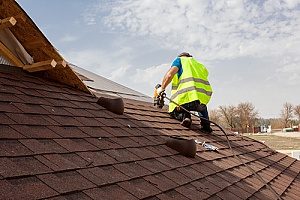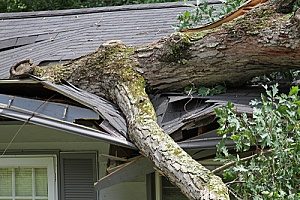 Replacing a roof is one of the most costly home improvement projects a homeowner will face. Fortunately, most homeowners insurance policies will cover all or part of a roof replacement, depending on the cause. For example, a standard all-perils homeowners insurance policy will cover a roof replacement regardless of age if the damage was caused by an act of nature. However, this is not the case with all policies. Learn more about what the average homeowners insurance policy covers and what is not covered so that you can understand what to expect from homeowners insurance.
Replacing a roof is one of the most costly home improvement projects a homeowner will face. Fortunately, most homeowners insurance policies will cover all or part of a roof replacement, depending on the cause. For example, a standard all-perils homeowners insurance policy will cover a roof replacement regardless of age if the damage was caused by an act of nature. However, this is not the case with all policies. Learn more about what the average homeowners insurance policy covers and what is not covered so that you can understand what to expect from homeowners insurance.
What is Covered by Homeowners Insurance
Storm damage is typically covered by most homeowners insurance policies. As the roof of your home is exposed to wind, rain, heat, and snow throughout the year, it must be able to hold up to harsh conditions. However, even well-built roofs cannot always withstand the power of a storm. Most homeowners insurance policies will cover water and ice damage, hail and wind damage, and damage from fallen trees, power surges, and lightning strikes. It is important to read your policy to determine what types of storm damage are covered and which are not.
Your homeowners insurance policy will generally cover roof leaks and similar types of damage, as long as the damage is not specifically excluded by your policy. However, whether or not you are entitled to coverage will depend on the cause of the leak. Perils covered by most homeowners insurance policies include theft, vandalism, falling objects, explosions, fire and smoke, damage from vehicles and aircrafts, windstorms, and excess weight due to ice, sleet, and snow. Your policy may also cover damage from riots, volcanic eruptions, sudden and accidental electrical surges, or the accidental or sudden cracking, breaking, or bursting of household amenities or pipes.
Your homeowners insurance may also cover water damage in some situations. If the damage was caused by a covered peril, such as a windstorm or fallen tree, your policy will likely cover any water damage incurred. If the damage is severe, many insurance policies will cover the full repair or replacement cost of the damaged roof, as long as the roof is less than ten years old. You may also receive reimbursement for older roofs, but only for the roof’s depreciated value. Some modern insurance policies will also provide coverage for mold remediation if the mold was caused by a covered peril.
What is Not Covered Under a Homeowners Insurance Policy
 Homeowners insurance covers many types of roof damage, but not all. For example, natural disasters such as floods and earthquakes are typically not covered by basic homeowners insurance policies. Landslides, sinkholes, and mudslides are also not generally covered. There may also be exclusions when it comes to vermin, fungus, and other types of deterioration.
Homeowners insurance covers many types of roof damage, but not all. For example, natural disasters such as floods and earthquakes are typically not covered by basic homeowners insurance policies. Landslides, sinkholes, and mudslides are also not generally covered. There may also be exclusions when it comes to vermin, fungus, and other types of deterioration.
Water damage to your home may not be covered if the homeowner is believed to be responsible for the damage. For example, say that you fail to clean out your rain gutters and they fill with debris, causing water to flow down the sides of your home and pool around your foundation. The pooling may result in interior water damage. Typically, this damage would not be covered by your insurance as you failed to undergo preventive maintenance by cleaning out the gutters.
General maintenance plays a direct role in whether your roof damage claim is approved or denied. The insurance company expects homeowners to perform routine maintenance to keep their home in optimal condition. Regular roof maintenance is designed to prolong the life of your roof and discover damage early on to prevent more costly repairs. If you do not have your roof inspected and repaired regularly, you may need a premature roof replacement. If the insurance company roof inspector finds that you have failed to perform routine maintenance, the insurance company may deny your claim or only provide partial reimbursement.
While all homeowners insurance policies differ, other hazards may also be excluded from your policy. These exclusions may include damage caused by the infestation of insects or animals, damage caused by your pets, rust or corrosion damage, smog damage, settling or cracking of your home’s foundation, and damage caused by war or government action. Mold and fungus grow will usually be covered by insurance unless the damage is not caused by a covered incident. For example, if mold grows inside a room that is naturally damp and not by a leaking roof, your insurance will not usually cover the damage.
Signs You Need Roof Replacement
 It is not always easy to determine whether or not your roof needs to be replaced without having to undergo a professional inspection. However, there are certain signs to look out for that may point to the need for roof replacement. The average lifespan of an asphalt shingle roof is 15 years. Tile and metal roofs last slightly longer. If your roof has reached or surpassed its expected lifespan, you may want to consider a roof replacement. Signs of potential roof damage include missing or curling shingles, broken or damaged flashing, and the formation of ice dams which signal a ventilation issue.
It is not always easy to determine whether or not your roof needs to be replaced without having to undergo a professional inspection. However, there are certain signs to look out for that may point to the need for roof replacement. The average lifespan of an asphalt shingle roof is 15 years. Tile and metal roofs last slightly longer. If your roof has reached or surpassed its expected lifespan, you may want to consider a roof replacement. Signs of potential roof damage include missing or curling shingles, broken or damaged flashing, and the formation of ice dams which signal a ventilation issue.
You will also want to look inside your home for signs of roof damage. You may notice areas where your walls and ceiling are discolored. This may be caused by water dripping inside from the roof. Also go into your attic and check the insulation. If it feels soggy, you may have a leak. The presence of unwanted insects or animals also means that there are entry and exit holes somewhere in your roof or side of the house. When discovered by birds, bats, raccoons, or squirrels, these pests may take up residence in your home.
Learn More About Roof Replacement
It is a question frequently asked by homeowners: “Does homeowners insurance cover roof replacement?” This answer is ‘it depends.’ While homeowners insurance policies do cover a wide range of incidents ranging from storm damage to fire destruction, there are certain exclusions found on every insurance policy. For more information about roof replacement or to schedule an inspection of your roof, contact the roof replacement contractors at Beyond Exteriors.